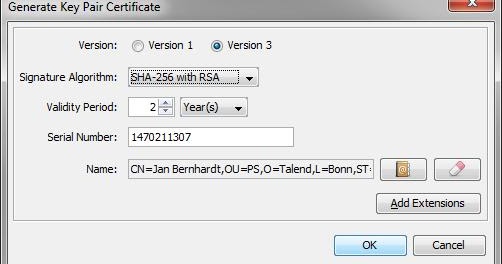Generate Rsa Key Pair Using Java
Posted By admin On 14.12.20In order to be able to create a digital signature, you need a private key. (Its corresponding public key will be needed in order to verify the authenticity of the signature.)
In other cases the program needs to generate the key pair. A key pair is generated by using the KeyPairGenerator class. In this example you will generate a public/private key pair for the Digital Signature Algorithm (DSA). You will generate keys with a 1024-bit length. Generate RSA keys with SSH by using PuTTYgen. Last updated on: 2016-06-23; Authored by: Rackspace Support; One effective way of securing SSH access to your cloud server is to use a public-private key pair. This means that a public key is. You can generate a secure shell (SSH) key pair for an Oracle Java Cloud Service instance on a UNIX or UNIX-like platform by using. Specify a filename for the private key. Also specify the RSA type and a size of 2048. (SSH) key pair for an Oracle Java Cloud Service instance on a UNIX or UNIX-like platform by using the ssh-keygen utility.
In some cases the key pair (private key and corresponding public key) are already available in files. In that case the program can import and use the private key for signing, as shown in Weaknesses and Alternatives.
In other cases the program needs to generate the key pair. A key pair is generated by using the KeyPairGenerator class.
In this example you will generate a public/private key pair for the Digital Signature Algorithm (DSA). You will generate keys with a 1024-bit length.

Generating a key pair requires several steps:
How To Generate Rsa Key Pair In Java
Create a Key Pair Generator
The first step is to get a key-pair generator object for generating keys for the DSA signature algorithm.
As with all engine classes, the way to get a KeyPairGenerator object for a particular type of algorithm is to call the getInstance static factory method on the KeyPairGenerator class. This method has two forms, both of which hava a String algorithm first argument; one form also has a String provider second argument.
A caller may thus optionally specify the name of a provider, which will guarantee that the implementation of the algorithm requested is from the named provider. The sample code of this lesson always specifies the default SUN provider built into the JDK.
Put the following statement after the
line in the file created in the previous step, Prepare Initial Program Structure:
Initialize the Key Pair Generator
The next step is to initialize the key pair generator. All key pair generators share the concepts of a keysize and a source of randomness. The KeyPairGenerator class has an initialize method that takes these two types of arguments.
The keysize for a DSA key generator is the key length (in bits), which you will set to 1024.
The source of randomness must be an instance of the SecureRandom class that provides a cryptographically strong random number generator (RNG). For more information about SecureRandom, see the SecureRandom API Specification and the Java Cryptography Architecture Reference Guide .
/key-generator-sims-4-dlc.html. The following example requests an instance of SecureRandom that uses the SHA1PRNG algorithm, as provided by the built-in SUN provider. The example then passes this SecureRandom instance to the key-pair generator initialization method.
Some situations require strong random values, such as when creating high-value and long-lived secrets like RSA public and private keys. To help guide applications in selecting a suitable strong SecureRandom implementation, starting from JDK 8 Java distributions include a list of known strong SecureRandom implementations in the securerandom.strongAlgorithms property of the java.security.Security class. When you are creating such data, you should consider using SecureRandom.getInstanceStrong(), as it obtains an instance of the known strong algorithms.
Generate the Pair of Keys
The final step is to generate the key pair and to store the keys in PrivateKey and PublicKey objects.
The Java KeyPairGenerator class (java.security.KeyPairGenerator) is used to generate asymmetric encryption / decryption key pairs. An asymmetric key pair consists of two keys. The first key is typically used to encrypt data. The second key which is used to decrypt data encrypted with the first key.
Public Key, Private Key Type Key Pairs
The most commonly known type of asymmetric key pair is the public key, private key type of key pair. The private key is used to encrypt data, and the public key can be used to decrypt the data again. Actually, you could also encrypt data using the public key and decrypt it using the private key.
The private key is normally kept secret, and the public key can be made publicly available. Thus, if Jack encrypts some data with his private key, everyone in possession of Jack's public key can decrypt it.
Creating a KeyPairGenerator Instance
To use the Java KeyPairGenerator you must first create a KeyPairGenerator instance. Creating a KeyPairGenerator instance is done by calling the method getInstance() method. Here is an example of creating a Java KeyPairGenerator instance:
The getInstance() method takes the name of the encryption algorithm to generate the key pair for. In this example we use the name RSA.
Initializing the KeyPairGenerator
Windows Generate Rsa Key Pair
Depending on the algorithm the key pair is generated for, you may have to initialize the KeyPairGenerator instance. Initializing the KeyPairGenerator is done by calling its initialize() method. Here is an example of initializing a Java KeyPairGenerator instance:
Java Generate Rsa Key Pair
This example initializes the KeyPairGenerator to generate keys of 2048 bits in size.
Generating a Key Pair
Generate Rsa Public Key
To generate a KeyPair with a KeyPairGenerator you call the generateKeyPair() method. Here is an example of generating a KeyPair with the KeyPairGenerator: